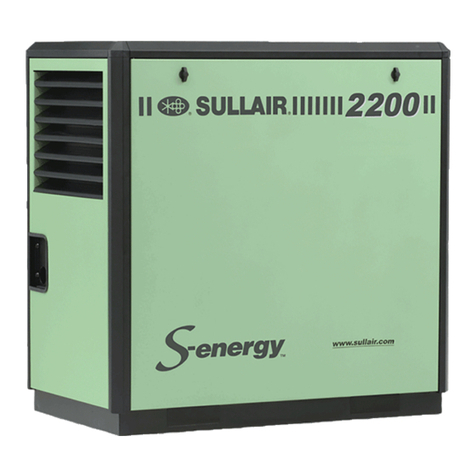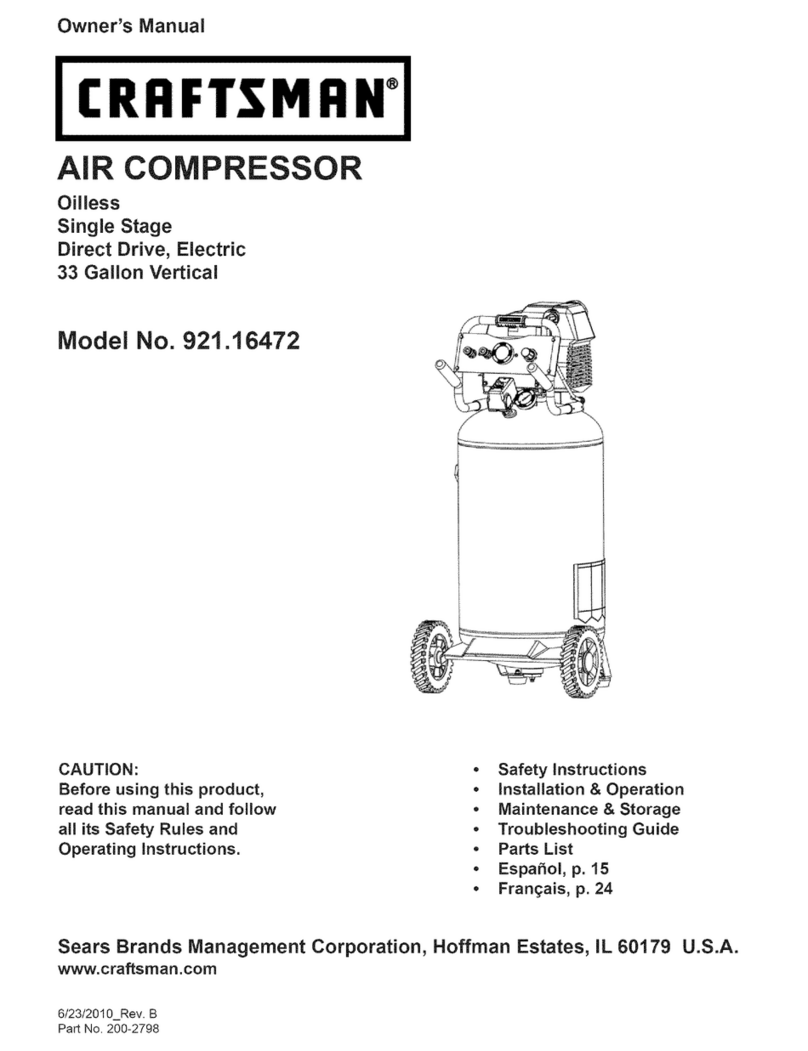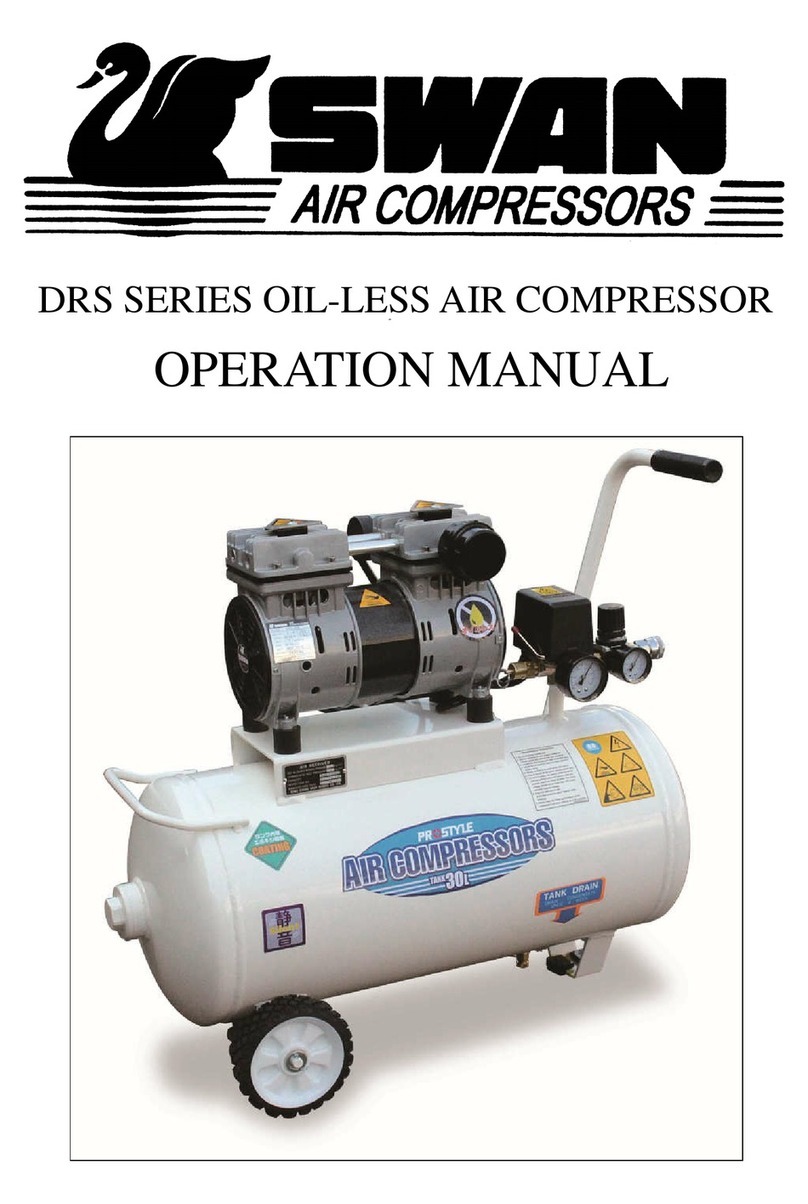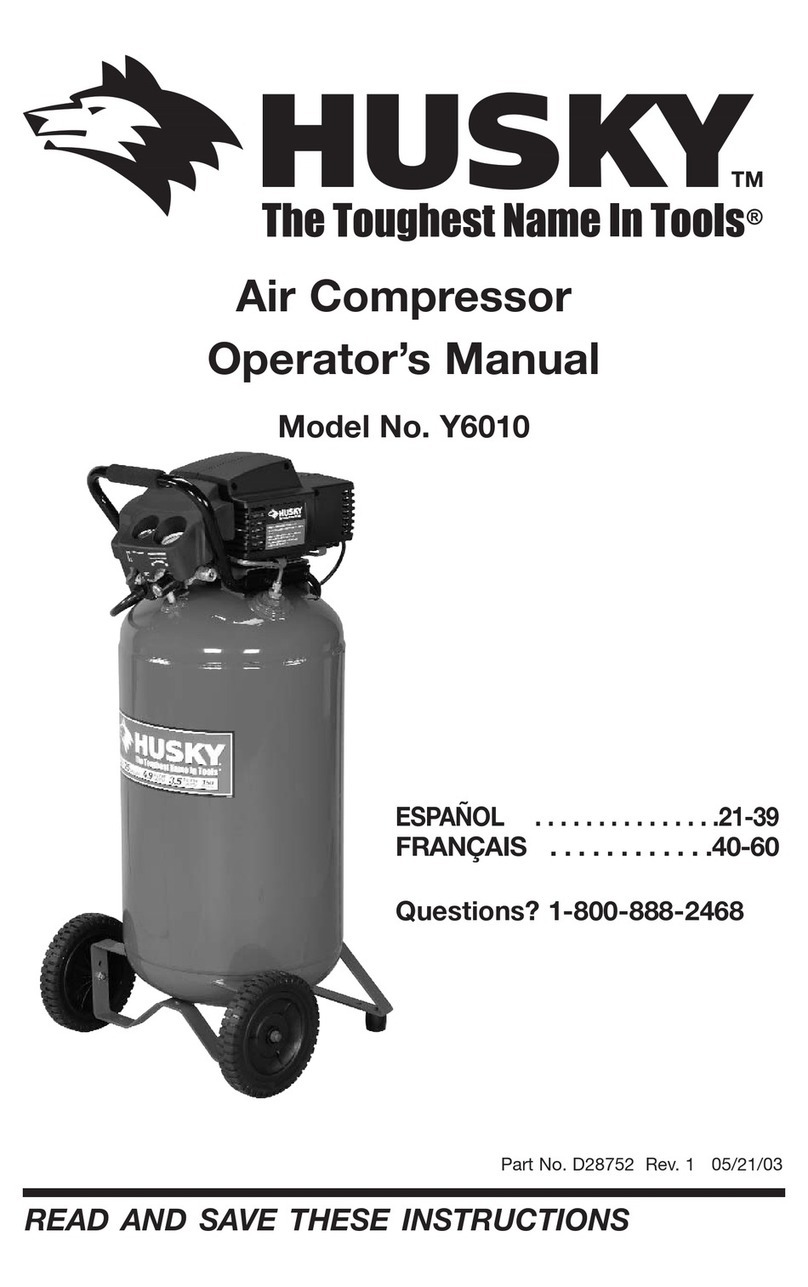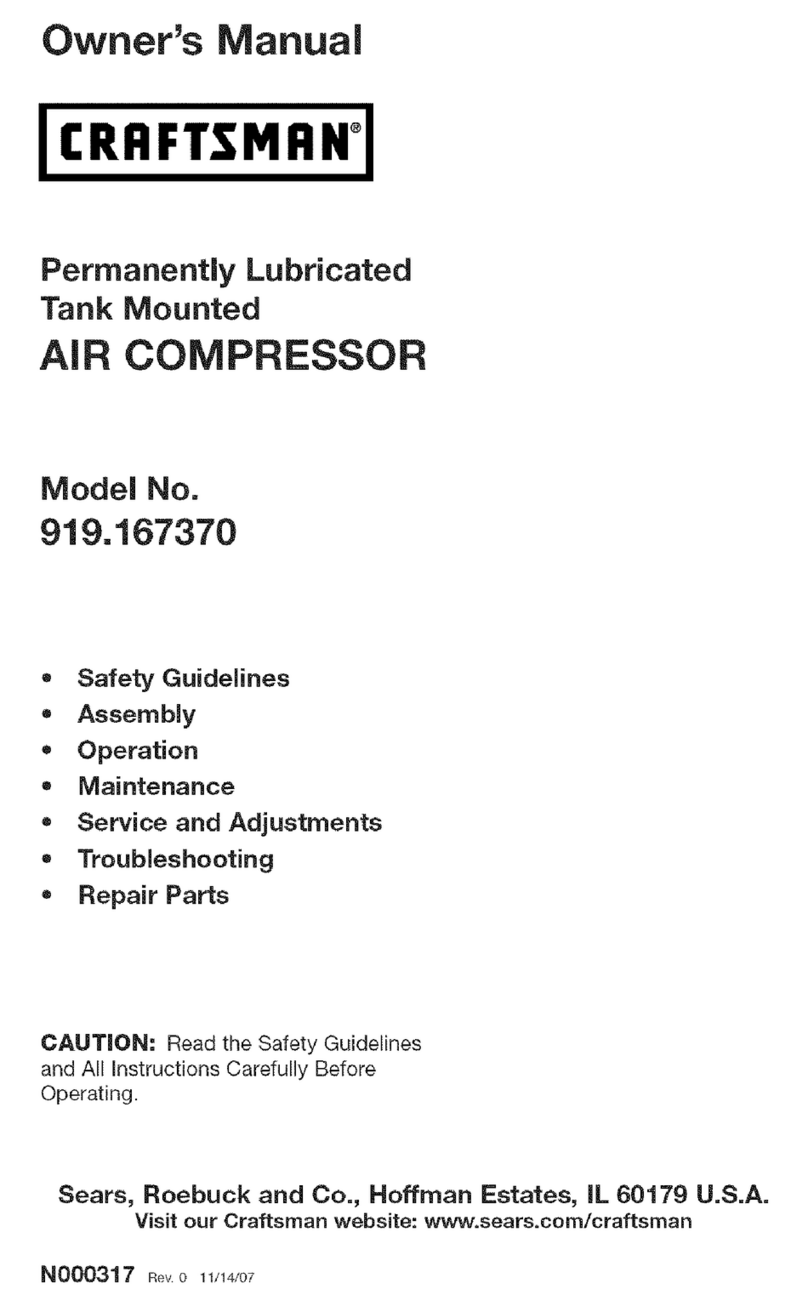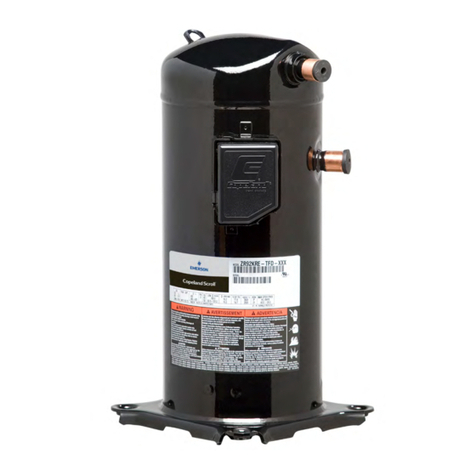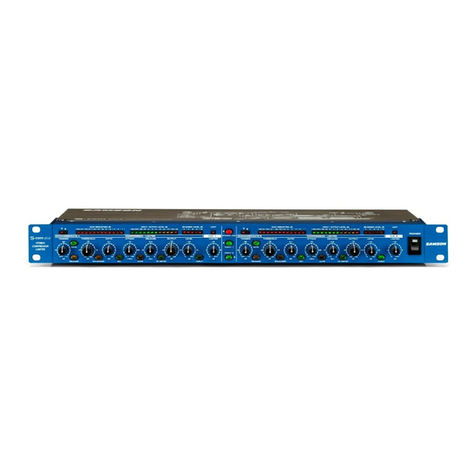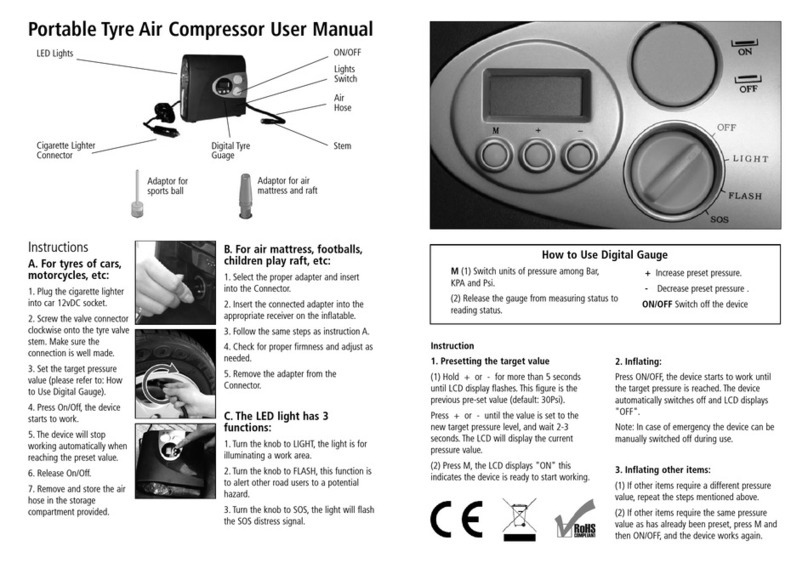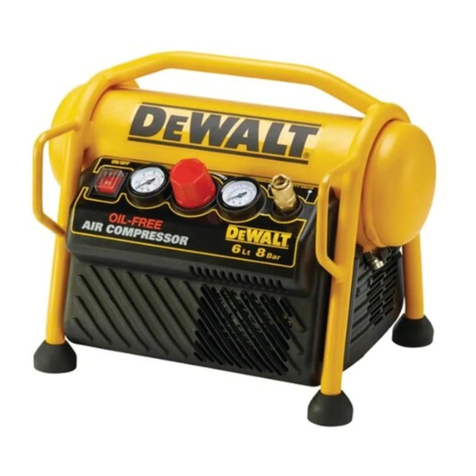Black Stone SBC 09-07 User manual

Mute Oil Free Air
Compressor
106353 SBC 09-07
106354 SBC 24-10
106355 SBC 50-10

Operating instructions
Please read and save these instructions. Read carefully before attempting to assemble, install, operate or maintain the produ ct described.
Protect yourself and others by observing all safety information. Failure go comply with instructions could result in personal injury and/or
property damage! Retain instructions for future reference.
DESCRIPTION
Oilless compressors are designed for do-it-yourselfers with a variety of home and automotive jobs. These compressors power spray guns,
impact wrenches and other tools. These units operate without oil. Compressed air from this unit will contain moisture. Install a water filter
or air dryer if application requires dry air.
SAFETY GUIDELINES
This manual contains information that is very important to know and understand. This information is provided for SAFETY and to PREVENT
EQUIPMENT PROBLEMS. To help recognize this information, observe the following symbols.
DANGER!
Danger indicates an imminently hazardous situation, which, if not avoided, will result in dea th or serious injury.
WARNING!
Warning indicates a potentially hazardous situation, which,if not avoided, could result in death or serious injury.
CAUTION!
Caution indicates a hazardous situation, which, if not avoided, MAY result in minor or moderate injury.
NOTICE!
Notice indicates important information that if not followed, MAY cause damage to equipment
UNPICKING
After unpacking the unit, inspect carefully for any damage that may have occurred during transit. Make sure to tighten fittin gs, bolts, etc,
before putting unit into service. Remove eventual transport caps before tightening the air filter/s.
WARNING!
Do not operate unit if damaged during shipping, handling or use. Damage may result in bursting and cause injury or property damage.
DANGER!
Breathable Air Warning
This compressor is not equipped and should not be used “as is “ to supply breathing quality air. For any application ofair for human
consumption, the air compressor will need to be fitted with suitable in-line safety and alarm equipment. This additional equipment is
necessary to properly filter and purify the air to meet minimal specifications for Grade D breathing as described in Compressed Gas
Association Commodity Specification G7.1-1966, OSHA 29 CFR 1910.134, and/or Canadian Standards Associations (CSA).
GENERAL SAFETY INFORMATION
Since the air compressor and other components(material pump, spray guns, filters, lubricators, hoses, etc.) used, make up a high pressure
pumping system, the following safety precautions must be observed at all times:
Read all manuals included with this product carefully. Be thoroughly familiar with the controls and the proper use of the equipment.
Follow all local electrical and safety codesas well as in the US, National Electrical Codes (NEC) and Occupational safety and Health Act
(OSHA).
Only persons well acquainted with these rulesof safe operation should be allowed to use the compressor.
Keep visitorsaway and NEVER allow children in the work area.
Wear safety glasses and use hearing protection when operating the pump or unit.
Do not stand on or use the pump or unit as a handhold.

Before each use, inspect compressed air system and electrical componentsfor signs of damage, deterioration, weakness or leakage, Repair
or replace defective items before using.
Check all fasteners at frequent intervals for proper tightness.
WARNING
Motors, electrical equipment and controls can cause electrical arcs that will ignite a flammable gas or vapor,
Never operate or repair in or near a flammable gas or vapor, Never store flammable liquids or gases in the vicinity of
the compressor.
CAUTION!
Compressor parts may be hot even if the unit is stopped.
9. Keep fingers away from a running compressor, fast moving and hot parts will cause injury and/or burns.
10. If the equipment should start to abnormally vibrate, STOP the engine/motor and check immediately for the cause, vibration is generally
a warning of trouble.
11. To reduce fire hazard, keep engine/motor exterior free of oil, solvent, or excessive grease.
12.
WARNING!
Never remove or attempt to adjust safety valve Keep safety valve free from paint and other accumulations.
DANGER!
Never attempt to repair or modify a tank!
Welding, drilling or any other modification will weaken the tank resulting in damage from rupture or explosion. Always replac e worn or
damaged tanks.
Drain liquid from tank daily.
WARNING!
13. Tanks rust from moisture build-up, which weakens the tank. Make sure to drain tank regularly and inspect periodically for unsafe
conditions such as rust formation and corrosion.
14. Fast moving air will stir up dust and debris, which may be harmful. Release air slowly when draining moisture or depressurizing the
compressor system.
SPRAYING PRECAUTIONS
WARNING!
Do not spray flammable materials in vicinity of open flame or near ignition sources including the compressor unit
15. Do not smoke when spraying paint, insecticides, or other flammable substances.
16. Use a face mask/respirator when spraying and spray in a well ventilated area to prevent health and fire hazards.
17. Do not direct paint or other sprayed material at the compressor. Locate compressor as far away from the spraying area as possible to
minimize overspray accumulation on the compressor.
18. When spraying or cleaning with solvents or toxic chemicals, follow the instructions provided by chemical manufacturer.
ASSEMBLY
WHEEL ASSEMBLY
Fit the wheels shown in Figure 1.
Figure 1

INSTALLATION
LOCATION
It is extremely important to install the compressor in a clean, well ventilated area where the surrounding air temperature wi ll not be more
than 100° F.
A minimum clearance of 18 inchesbetween the compressor and a wall is required because objectscould obstruct airflow.
CAUTION
Do not locate the compressor air inlet near steam, paint spray, sandblast areas or any other source of contamination. This debris will damage
the motor.
ELECTRICAL INSTALLATION
WARNING
All wiring and electrical connections should be performed performed by a qualified electrician. Installation must be in accordance with local
codes and national electrical codes.
CAUTION!
Never use an extension cord with this product Use additional air hose instead of an extension cord to avoid power loss and pe rmanent
motor damage; Use of an extension cord voids the warranty.
GROUNDING INSTRUCTIONS.
1. This product is for use on a nominal 230 volt circuit and has a grounding plug that looks like the plug illustrated in Fig.3.Make sure the
product is connected to an outlet having the same configuration as the plug. This product must be grounded. In the event of a n electrical
short circuit, grounding reduces risk of electrical shock by providing an escape wire for electric current. This product is equipped with a cord
having a grounding wire with an appropriate grounding wire with an appropriate grounding plug. Plug must be plugged into an o utlet that is
properly installed and grounded in accordance with all local codes and ordinances.
DANGER!
Improper use of grounding plug can result in a possible risk of electrical shock!
DANGER!
Do not use a grounding adapter with this product!
2. If repair or replacement of cord or plug is necessary, do not connect grounding wire to either flat blade terminal. The wire with insulation
having an external surface that is green (with or without yellow stripes)is the grounding wire.
Never connect green(or green and yellow) wire to a live terminal.
3. Check with a qualified electrician or serviceman if grounding instructions air not completely understood, or if in doubt as t o whether
product is properly grounded. Do not modify plug provided; if it will not fit outlet, have proper outlet installed by a qualified electrician.
4.
WARNING!
1. Local electrical wiring codes differ from area to area. Source wiring, plug and protector must be rated for at least the ampe rage and
voltage indicated on motor nameplate, and meet all electrical codesfor this minimum,
2. Use a slow blow fuse or a circuit breaker.

OPERATION
Pressure Switch-Auto/Off Switch-In the AUTO position, the compressor shuts off automatically when tank pressure reaches the maximum
preset pressure. In the OFF position, the compressor will not operate. This switch should be in the OFF position when connecting or
disconnecting the power cord from the electrical outlet or when changing air tools.
Regulator-The regulator controls the amount of air pressure released at the hose outlet.
Safety Valve-This valve automatically releases air if the tank pressure exceeds the preset maximum.
Discharge Tube-This tube carries compressed air from the pump to the check valve. This tube becomes very hot during use. To avoid the
risk of severe bums, never touch the discharge tube. Check Valve-A one-way valve that allows air to enter the tank, but prevents air in the
tank from flowing back into the compressor pump. Handle-Designed to move the compressor.
▲WARNING!
Never use the handle on wheeled units to lift the unit completely off the ground.
Drain Petcock-This valve is located on the bottom of the tank. Use this valve to drain moisture from the tank daily to reduce the risk of
corrosion.
Reduce tank pressure below 10 psi, and then drain moisture from tank daily to avoid tank corrosion. Drain moisture from tank by opening
the drain petcock located underneath the tank.
LUBRICATION
This is an oilless product and DOES NOT require lubrication to operate.
MOISTURE IN COMPRESSED AIR
Moisture in compressed air will forminto droplets as itcomes from an air compressor pump.When humidity is high or when
a compressor is in continuous use for an extended period of time, this moisture will collect in the tank. When using a paint
spray or sandblast gun, this water will be carried from the tank through the hose,and out of the gun as droplets mixed with
the spray material.
IMPORTANT: This condensationwillcause waterspotsin a paintjob, especially when spraying other than waterbased paints.
If sandblasting,itwill cause the sand tocase and clog the gun renderingit ineffective. A filter in the air line (MP3105), located
as near tothe gun as possible, willhelp eliminate this moisture.
SAFETY VALVE
Do not remove or attempt to adjust the safety valve!
This valve should be checked underpressureoccasionally bypullingthe ringby hand.If air leaks after ring has been released,
or valve is stuck and cannotbe actuated byring,itMUST be replaced.
REGULATORKNOB(figure 5)
l .This knob controls air pressureto an air-operated tool or paintspray gun.
2. Turn clockwise toincrease air pressure atoutlet.When desired pressureis reached,lockedwith nuts.
3. To lower air pressureatoutlet,turning counterclockwise.
3.Turn fully counterclockwiseto shutoff flowof air completely then push knob down.
TANK PRESSURE GAUGE
Gauge shows pressure in tank indicating compressor is building pressure properly.
MAINTENANCE
WARNING!
Disconnect power source then release all pressure from the system before attempting to install, service, relocate or perform any
maintenance.
Check compressor often for any visibleproblems and follow maintenanceprocedures each time compressor is used.

1. Pull ringon safety valve and allowit to snap back to normal position.
WARNING!
Safety valve must be replaced if it cannot be actuated or it leaks air after ring is released.
2. Turn compressor off and release pressure from system. Drain moisture from tank by opening drain cock underneath tank.
3. Clean dust and dirt from motor, tank, and airlines and pump cooling fins while compressor is still OFF.
IMPORTANT: Locate unit as far from spraying area, as hose will allow preventing overspray from clogging filter.
LUBRICATION
This is an oillesstype compressor requiring no lubrication.
THERMAL OVERLOAD PROTECTOR compressor is equipped with an automatic reset thermal overload protector; which will shut off
motor if it becomes overheated.
If thermal overload protector shuts motor OFF frequently, look for the following causes.
1. Low voltage.
2. Clogged air filter.
3. Lack of proper ventilation.
CAUTION!
If the thermal overload protector is actuated, the motor must be allowed to cool down before start-up is possible. The motor will automatically
restart without warning if left plugged into electrical outlet and unit is turned on.
STORAGE
1. When not in use, store hose and compressor in a cool dry place.
2. Drain tank of moisture.
Disconnect hose and hang open ends down to allow any moisture to drain.
THROUBLESHOOTINGCHART
Symptom
Possible Cause (s)
Corrective Action
Compressor will not run
1. No electrical power
2. Blown fuse
3. Breaker open
4. Thermal overload open
5. Pressure switch bad
1. Plugged in? Check fuse/breaker or motor overload
2. Replace blownfuse
3. Reset, determine cause of problem
4. Motor will restart whencool
5. Replace
Symptom
Possible Cause (s)
Corrective Action
Motor hums but cannot run or runs slowly
1. Defectivecheck valve or
unloaded
2. Poor contacts, line
voltage low
3. Shorted or open motor
winding
1. Replace or repair
2. Check connections, eliminateextension cork ifused,
check circuit with voltmeter
3. Replace motor
DANGER! Do not disassemble check valve withair in tank;bleed
tank
Fuses blow/circuit breaker trips repeatedly
CAUTION! Never use an extension cord with
this product
1. Incorrectsize fuse,
circuit overloaded
2. Defectivecheck valve or
unloaded
1 .Check for proper fuse, use time-delay fuse. Disconnectother
electricalappliances fromcircuit oroperate compressor on its own
branch circuit2. Replaceor repair
DANGER! Do not disassemble check valve with air in tank;bleed
tank
Thermal overload protector cuts out
repeatedly
1. Low voltage
2. Clogged air filter
3. Lack of proper
ventilation/roomtemperature too
high
4. Check valve malfunction
5. Compressor valves failed
1. Eliminate extensioncord, check with voltmeter
2. Clean filter(see Maintenance section)
3. Move compressorto well ventilatedarea
4. Replace
5. Replace valveassembly
DANGER1 Do not disassemblecheck valvewith airin tank; bleed
tank
Knocks, rattles, excessivevibration
1 Loose bolts, tank notlevel
2. Defectivebearing on
eccentric ormotor shaft
3. CyLinder orpiston ring
is worn or scored
1. Tighten bolts, shimtank to levelposition
2. Replace
3. Replace or repair asnecessary
Troubleshooting Chart(Continued)
Symptom
Possible Cause (s)
Corrective Action
Tank pressure drops when compressor
shuts off
1. Loose drain cock
2. Check valve leaking
3. Loose connections at pressure
switch or regulator
1. Tighten
2. Disassemble check valveassembly,clean orreplace
3. Check all connections with soap and water solution and
tighten
Compressor runs continuously and air
output is lower than normal/lowdischarge
pressure
1. Excessive air usage,
compressor toosmall
2. Clogged intakefilter
3. Air leaks in piping (on
machine or inoutside system)
1. Decrease usage orpurchaseunitwith higher air delivery
(SCFM)
2. Clean or replace
3. Replace leaking components or tighten as necessary
4. Repl ace compressor valves

4. Broken inlet valves
5. Piston ring worn
5. Replace piston andcylinder
Excessive moisture indischargeair
1. Excessive waterin tank
2. High humidity
1. Drain tank
2. Move to area of less humidity; use air line filter NOTE: Water
condensation is not caused by compressor malfunction
Compressor runs continuously and safety
valve opens as pressure rises
1. Defectivepressureswitch
2. Defectivesafety valve
1. Replace switch
2. Replace safety valve withgenuine replacementpart
Excessive starting and stopping (auto start)
Excessive condensation intank
Drain more often
Air leaking from unloader onpressure
switch
Check valve stuck inan open
position
Remove and replace check valve
DANGER! Do not disassemblecheck valvewith air
in tank; bleedtank

PARTS ILLUSTRATION
OILLESS PARTS LIST
No.
Designation
price
Quantity
No.
Designation
price
Quantity
1
Bolt M5*25
31
Connects the bend
2
Plain cushion
32
Crash pad
3
Cylinder head
33
Nut M5
4
Air filter
34
M4x8
5
Seal packing collar
35
Capacitance
6
Air admission clamp
36
Electric capacity box
7
Valve piece
37
Discharge pipe
8
Valve plate subassembly
38
Release pipe
9
Exhaustclamp
39
checking valve
10
O circle
40
The wheel axle stacks
11
Cylinder
41
Rubber tire
12
Piston curl clamp
42
Washer loot
13
Piston ring
43
Washer water valve
14
Connection rob
44
tank
15
Crankcase
45
Power cord

16
Bearing 6203Z
46
Safety valve
17
Crank
47
Handle
18
Fan
48
Pressure switch
19
Clastic ring
49
Connector
20
Gate lid
50
Pressure regulator
21
Bolt
51
coupler
22
Bearing 6006Z
52
Nut
23
Stator sy vassembly
53
Pressure gauge50
24
Rotor
54
Pressure gauge40
25
Bolt M5* 155
26
Bolt M6* 16
27
Bolt M4*6
28
Bolt M4*8
29
O circle
30
Connectingpipe
This manual suits for next models
5
Table of contents
Popular Air Compressor manuals by other brands
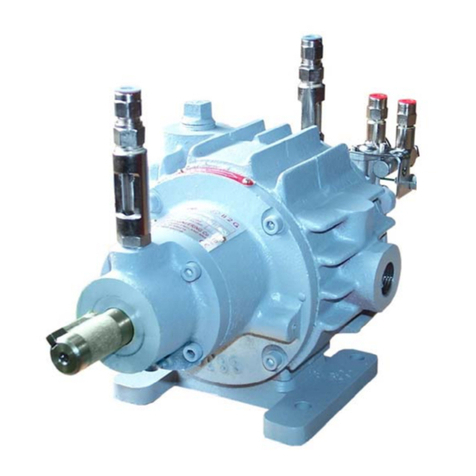
Utile
Utile LGB32 Installation, operation & maintenance instructions
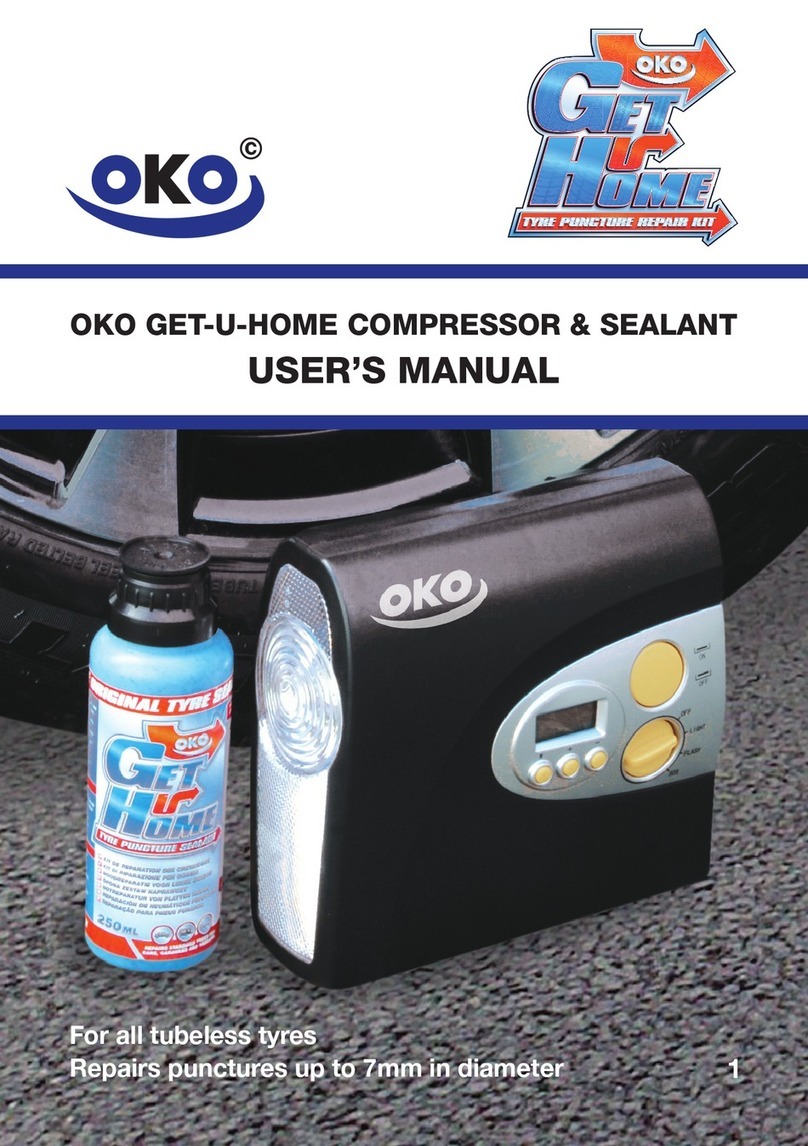
Oko
Oko GET-U-HOME user manual
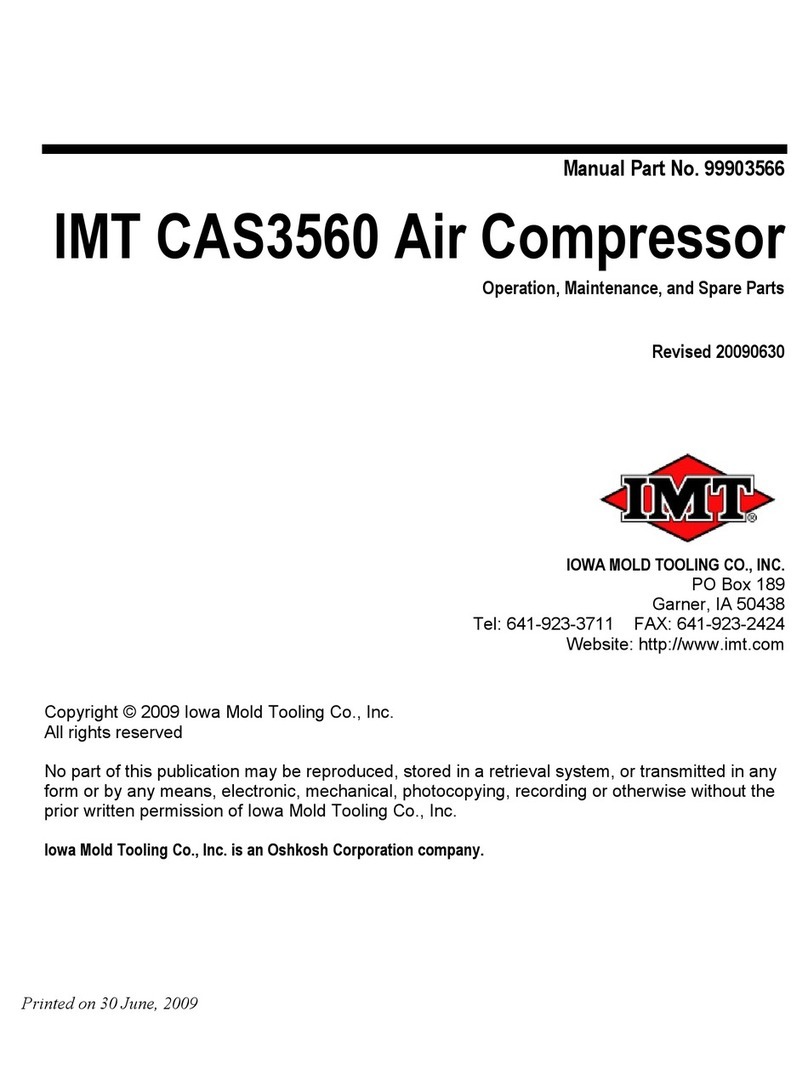
IMT
IMT CAS3560 Operation, maintenance and spare parts

Reliable
Reliable QRM2-25115-40 Installation, operation and maintenance manual
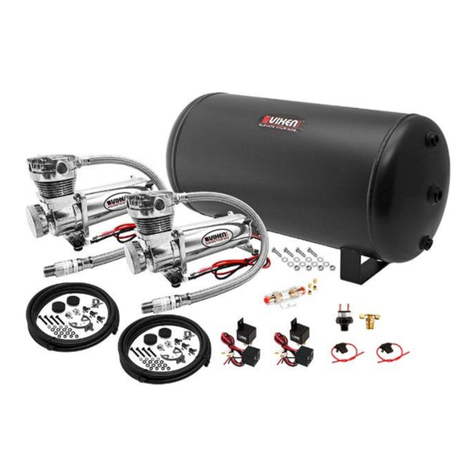
Vixen Air
Vixen Air VXO4863DC installation guide
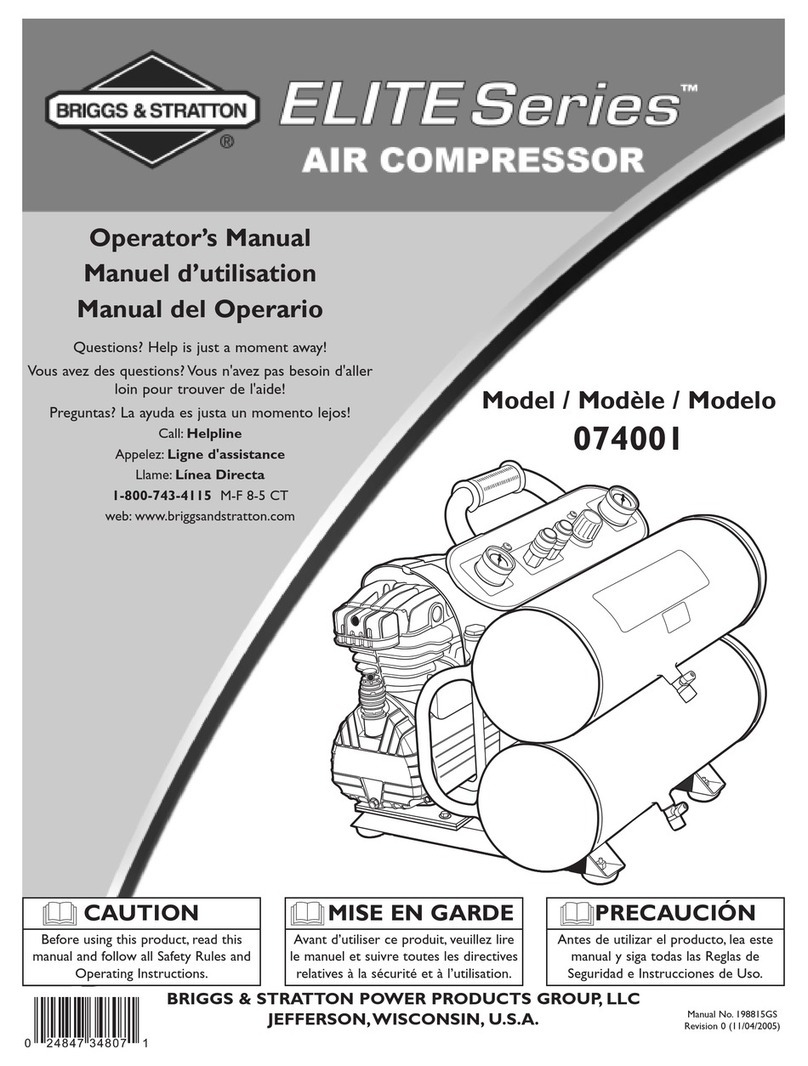
Briggs & Stratton
Briggs & Stratton 74001 Operator's manual
